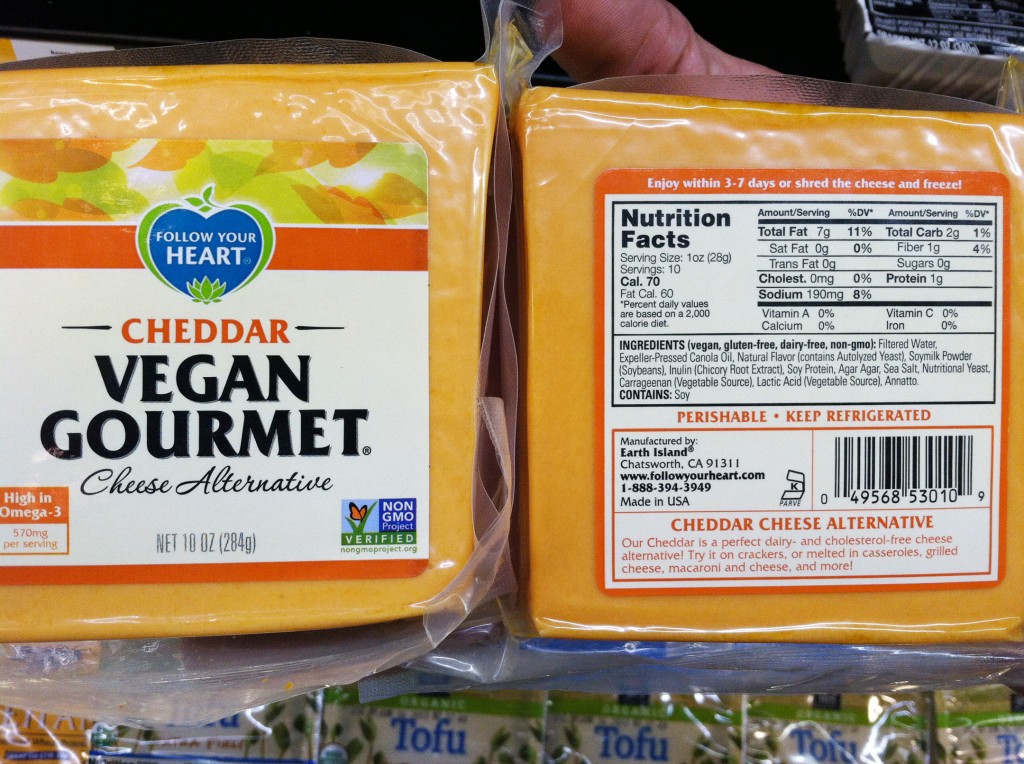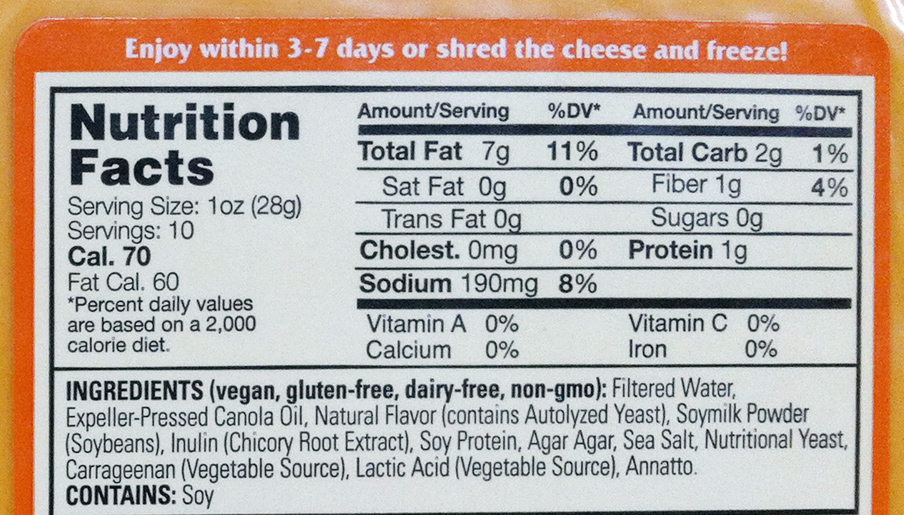I had a few people get their panties in a bunch when I posted this picture earlier today.
First, let me be clear that I am NOT hatin’ on people with dairy allergies, I’m not hatin’ on vegans, and I’m not judging your food choices if you eat this.
My point is simply this:
This isn’t cheese.
No, not even close.
Just take a look at these ingredients:
Do you even know what all these ingredients are?
First of all, the majority of this product is WATER. That’s almost as good as that “ham and water product” picture I posted.
Canola
The history of canola oil is chalk-full of thrill and intrigue. Canola is not actually a plant. The oil is derived from a the seed of the rape plant—rapeseed. A seed with less erucic acid was developed in Canada in the late 1970s, and “Canola” actually stands for “Canadian Oil, Low Acid.”
Rapeseed oil was originally an industrial oil, used for naval applications and to lubricate engines, since it has the unique property of sticking to wet metal. In 1995, Monsanto genetically engineered a Round-Up Ready rape plant, and now over 80% of the world’s Canola oil is GMO. The remaining 20% is subject to contamination due to cross-pollination, even if the crop starts out as organic or non-GMO. My point: It’s risky business consuming canola.
To quote Dawn Gifford from Small Footprint Family,
The bottom line is that Canola is an inflammatory oil in your body that contains foreign, genetically engineered DNA, trans fats, and toxic chemical residues. It is also an environmental scourge and a threat to organic farming, and it should be avoided at all costs.
You can read more about Canola Oil from Small Footprint Family HERE.
Natural flavor
“Natural flavor” is often just clever wording for MSG. In this case, the package specifies that the natural flavor is “Autolyzed Yeast,” which is MSG, plain and simple. Other hidden sources for MSG include Glutamic acid, Glutamate, Anything “hydrolyzed,” Gelatin, Textured protein, Whey protein, Soy protein, Maltodextrin, Carrageenan, Malt extract, Seasonings, and Barley malt—just to name a few. To see a full list, click HERE.
Why is MSG bad? MSG stands for Monosodium Glutamate, which is a chemical compound and excitotoxin. It is used as a flavor enhancer in many processed foods that you see on the grocery store shelves. The short version of this story is that MSG can cause cell death in the brain, lead to nervous disorders, adversely affect your hormone levels, cause migraines, ADD/ADHD, seizures, heart palpitations, and contribute to obesity.
For the long story of MSG, check out this article from Food Renegade HERE.
Soy
Soy is mentioned twice in this ingredient list as Soymilk powder and Soy Protein. Don’t be fooled. Soy is no health food, and it’s best avoided by men, women, children, and babies alike.
Today’s soy is not prepared like traditional and fermented soy. Today’s soy is processed processed processed—the result of industrial waste, repurposed, chemically changed, and marketed to the consumer as “healthy.”
Some effects of soy include:
Bottom line? Stay away from soy that hasn’t been fermented. Read more from Dr. Kaayla Daniel HERE.
Carrageenan
Put simply, carrageenan is an emulsifier. Here, it’s used in conjunction with agar agar to thicken & stabilize the consistency of this colored/flavored water & oil product. It is derived from red seaweed and prevents separation, improves texture and mouthfeel. It is also responsible for causing massive amounts of inflammation, especially in the gut.
According to the Cornucopia Institute, carrageenan is responsible for a number of health problems, including irritable bowel syndrome/IBS, spastic colon, inflammatory bowel disease, and chronic diarrhea.
More often than not, these health problems are mistakenly blamed on the foods to which carrageenan is added—not the carrageenan itself. And carrageenan is unfortunately very common in organic foods, as well as conventional foods. Be sure to read your labels!
To reiterate:
The point of this post is not to bash vegans or people with dairy allergies. It’s simply to make you think about what’s REALLY in your food! This is NOT food!! And it’s certainly not CHEESE!
Be smart about what you put in your mouth.
It would be better to avoid this entirely than to settle for this toxic “cheese alternative.”
Featured on Frugal Days, Sustainable Ways.



Thank you for sharing this!!!
I love reading stuff like this. I really never know what most ingredients are. I am very ill now and am in the process of going vegan and gmo free. It has been less than one week, and I am already starting to feel a bit better. I would love to know which products to buy that are made for you as I am no cook. I wish I were. Thanks again!
Ewwww!!
Unfortunately, in today’s world there are 2 things missing…people that cook from scratch and people with brains that at least read the labels and comprehend whats in a “convenient” product. I call processed foods a convenient product, because it really has absolute nothing to do with real food.
I agree. It amazes me every time someone asks me if I “really” made “that” from scratch!! It’s the only way I know how to cook. I don’t like box mixes and I don’t like all of the mystery ingredients that abound. In all products. So, when I make it from scratch I not only control the amount of the ingredients, but I control *what* is in what I make.
I’ve even had people tell me not to make certain things “healthy” when I am bringing a dish to a potluck. I believe that if I don’t want to eat it, why would I give it to someone else??
The good news is, more and more people are seeing the value of learning simple daily meal planning. With the economy seeming to be permanently in the toilet, it’s become essential to know how to cook at least basic foods. I went from boxed pasta and jarred sauce three days a week to grinding my own meat from our farmer co-op in only 2 years. It’s not impossible to inspire people to learn it. I love to bring leftovers to work and explain what I did to create them to my colleagues. occasionally, I see it mirrored back at me. Rather than lament what you perceive to be a problem, why not try to advocate and inspire. Start with the people who ask you about what you’re eating. Be excited about how awesome your food is, sometimes it’s just that simple.
Why it says non GMO?
The canola oil that was used wasn’t grown from genetically modified seed. I avoid canola regardless of non-gmo or organic status because so much of the canola crop is contaminated by gmo cross-pollination.
it also has soymilk, which is not organic, but probably gmo free. Still yuck